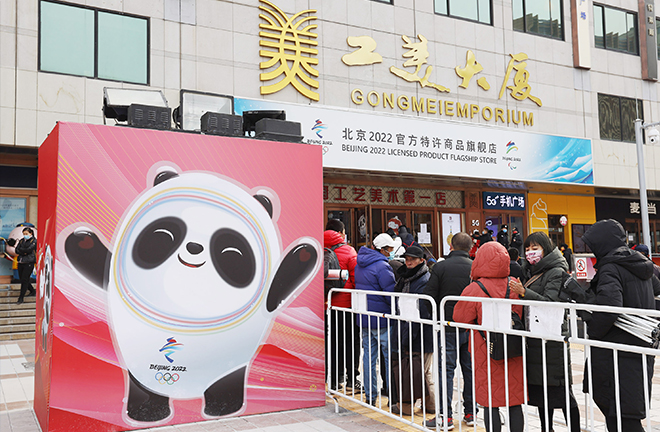Beijing 2022 mascot Bing Dwen Dwen goes viral

Customers line up in front of a flagship store selling licensed products from the Beijing Winter Olympics in Beijing Photo: Lyu Jiazuo/CSST
Bing Dwen Dwen, the mascot of the 2022 Beijing Winter Olympics, has captured the hearts of hundreds of millions of spectators. As of February 14, topics tagged “Bing Dwen Dwen” on Sina Weibo had over 4.8 billion views.
Bringing countries together
“We hoped to make it a cute panda image that is acceptable to all age groups and integrates the three elements of culture, artistry, and commerciality,” said Cao Xue, leader of Bing Dwen Dwen design team, and a professor at the Guangzhou Academy of Fine Arts.
Bing Dwen Dwen’s popularity today benefits from the combined effect of creative marketing, scene marketing, visual marketing, and event marketing, noted Jin Yuanpu, director of the Institute of Cultural and Creative Industries at Renmin University of China. “Creativity is paramount” is the fundamental law of cultural creativity, and the success of Bing Dwen Dwen’s image and creativity is the foundation for its viral popularity.
In addition, in the electric atmosphere of the Winter Olympics, the public’s attention is focused on all things related to the Games, which is the most important “booster” for Bing Dwen Dwen’s popularity. At the same time, a variety of factors have caused a reluctance to sell (short of sale) licensed products such as Bing Dwen Dwen, which has formed the actual effect of hunger marketing, Jin said.
Reducing cultural distance and “cultural discount” is essential for a successful cultural and creative product, said Yang Yongzhong, director of the Institute of Creative Management at Sichuan University. [The theory of cultural discount suggests that a product may be valued to a lesser extent by foreign audiences that lack the cultural background and knowledge needed for a full appreciation of the product.]
In terms of Bing Dwen Dwen’s appearance, the panda itself is a global symbol and language. Its full-body “shell” made out of ice, which resembles an astronaut suit, is a tribute to embracing new technologies. In appearance, it has narrowed the cultural distance among countries around the world.
From the inside, Bing Dwen Dwen conveys to people the qualities of friendliness, kindness, and honesty that all human beings pursue, which reduces the cultural discount in the process of communication. This is the reason why Bing Dwen Dwen is easily understood and loved by people from all over the world, Yang said.
Today, Bing Dwen Dwen is not just a mascot; it represents a friendly, warm, and confident image, showing the world a true and confident China.
Foreign language naming
Amid Bing Dwen Dwen’s popularity, the transliteration of its name, as well as the name “Shuey Rhon Rhon,” the mascot of the Beijing 2022 Paralympic Winter Games, has aroused attention and academic discussion. The foreign names of the two mascots, “Bing Dwen Dwen” and “Shuey Rhon Rhon,” are not standard Chinese pinyin [Bing Dun Dun, Xue Rong Rong] or a common English spelling.
“We can understand this as a transcription method that takes into account the characteristics of Chinese pronunciation and Indo-European languages, in order to solve the problem that there are no similar syllables or word formation methods such as ‘Dun,’ ‘Xue,’ and ‘Rong’ in the languages familiar to the target audiences, making it convenient for foreign audiences to read,” said Li Yan, executive director of the Institute of China Language Industry at Capital Normal University.
In cross-language and cultural communication, special attention should be paid to the communication barriers caused by linguistic and cultural differences, and appropriate methods should be sought to overcome these barriers to achieve the desired communication effect, Li continued.
Taking into account both Chinese and foreign languages showcases China’s friendly attitude towards the world, said Peng Zerun, vice president of the Chinese Language Modernization Society. Similarly, when a proper noun from a foreign language comes into the Chinese language, it has to undergo a Chinese phonology transformation so that it can be easily pronounced by Chinese users.
Although Bing Dwen Dwen is very “hot,” the experience summary around its design process should be “calm,” Cao said. We should not only summarize experience from the perspective of design, but also hope that more experts and scholars outside the design circle will discuss the Bing Dwen Dwen phenomenon to promote design education and the development of design concepts and practices.
Edited by JIANG HONG
